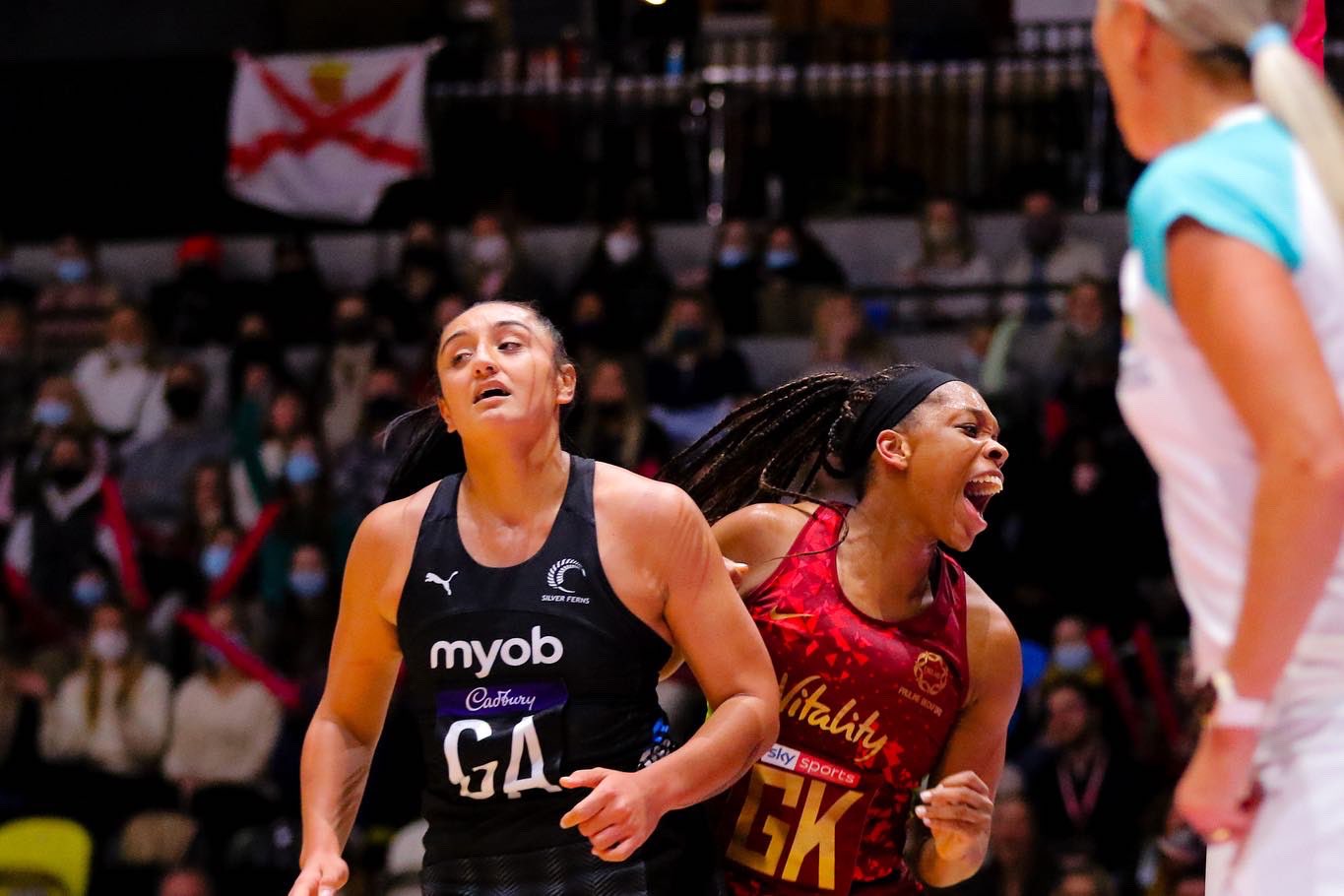
2022 QUAD SERIES – ROUND 2
Contributors: Andrew Kennedy, Katrina Nissen, Jenny Sinclair, Ian Harkin, Zara Collings, Rona Hunnisett
Australian Diamonds v South African Proteas
Starting Line-ups
Australia
GS – Gretel Bueta
GA – Steph Wood
WA – Paige Hadley
C – Kate Moloney
WD – Ash Brazill
GD – Maddy Turner
GK – Courtney Bruce
South Africa:
GS – Ine Mari Venter
GA – Lefebre Rademan
WA – Izette Griesel
C – Bongi Msomi
WD – Monique Reyneke
GD – Zanele Vimbela
GK – Phumza Maweni
Player of the Match: Courtney Bruce (Australia)
Shooting percentages
Australia:
Gretel Bueta 28/31 (90.3%), Sophie Garbin 18/191 (94.7%), Steph Wood 10/11 (90.9%), Cara Koenen 4/5 (80%)
South Africa:
Ine-Mari Venter 32/37 (86.5%), Lefebre Rademan 8/14 (57%), Jessica du Pessis 0/1 (0%)
Umpires: Kate Stephenson & Alison Harrison
Milestones
Congratulations Sunday Aryang, whose debut in the second quarter to become Diamond number #184. The West Australian is the first African-born Diamond.
Diamond number 184, Sunday Aryang. Image: Ben Lumley
Talking Points
South Africa stuck to the Diamonds in the first 30 minutes, being just four goals down at half time. It was a tentative period for the Diamonds, with new defensive and midcourt combinations being trialled. Paige Hadley and Kate Moloney didn’t gel immediately, lacking drive into clear space in the attacking third. It wasn’t until the third quarter that the pair looked more comfortable together, finding the top of the circle with more ease, while Hadley’s connection with Garbin in the circle was strong. Pleasingly, Hadley and Moloney gave away a measly four combined turnovers, limiting the Proteas ability to regain ball.
Maddy Turner and Courtney Bruce didn’t look quite comfortable together either, and it was probably no coincidence that the Diamonds defensive gains increased once Sunday Aryang joined Bruce on court in their Fever-familiar combination. However, there’s work still to be done for a goal defence to cover the back space, releasing Bruce to fly at the ball as she does so well at domestic level.
Jamie-Lee Price has been a late inclusion in both matches, coming on at centre in the back end of both matches, and will need to reduce her turnovers as she searches for more court time.
However, with a lack of match play limiting the Diamonds’ ability to trial such combinations over the past couple of years, all players will be better for the outing, and should continue to grow with time.
The Proteas made multiple interchanges throughout the game as they searched for winning combinations, making it challenging for players to settle into their work.
While we haven’t seen a Sophie Garbin/Gretel Bueta combination before today’s match, the pair fired immediately. Their strength in the circle was a highlight, helping the Diamonds to convincingly win the third quarter, 18-9.
What’s in a name? Courtney Bruce lost the “B” off her playing dress yesterday, with tape or texta used to convert the “R” to a “B”. In today’s match, the letters had all gone AWOL, and Bruce played in a spare dress without any name.
A lot of questions were asked about the on court Diamond’s captaincy with Liz Watson rested for this match, then Steph Wood rested at half time. Our on-site reporter, Zara Collings had all the answers: Captaincy passed to Courtney Bruce at halftime, then when Bruce was rested, the on-court captain became Paige Hadley.
Stand out players
Gretel Bueta’s flair was on display in the second half of the match. During the first she was kept quiet, but once she had her goal attack bib on and space to run, the whole front end lifted. Her combination with Sophie Garbin – a traditional holding shooter – added a familiarity to Bueta’s game which allowed her to deliver her lay-up style passes. But more importantly, the Diamonds benefited from Bueta’s defensive pressure in the middle third, where she picked up a loose ball and just clogged up the space for the Proteas.
Sunday Aryang made a debut to be proud of. Showing minimal nerves, she covered the ground and her opponent well, and picked off three gains in her 35 minutes on court.
The switch of Izette Griesel to WA, and Bongiwe Msomi to C, was pivotal for South Africa. Msomi was fluid on attack, proving to be a headache for her opposing centre, Kate Moloney, leaving Griesel to do the bulk of the circle feeding. Griesel finished, along with Paige Hadley, on a game high 30 feeds.
Phumza Maweni was perhaps the Proteas best performer – Bueta had few easy balls against her in the first half, with Maweni edging her away from the post and coming up with four gains.
Interesting statistics
In a good display of through-court defence, eight of the Diamonds 12 players came up with gains. Courtney Bruce had a game high five, although debutante Sunday Aryang, Kate Moloney and Ash Brazill chimed in with three each.
Overall consistency was an issue for both sides, with some disappointing measures as a result. The Diamonds scored from just 68% of their centre passes, while the Proteas were lower on 55%. Gains to goals were also in their 60s (Diamonds 68%, Proteas 67%), however it was the turnover to goal percentage that will haunt the Proteas. They converted just 31%, to the Diamonds 81%.
It must be noted however that during the third quarter, both teams had 14 centre passes. Australia scored from every single one of theirs while the Proteas only scored from half of theirs. This was when Australia started to extend the gap on the scoreboard.
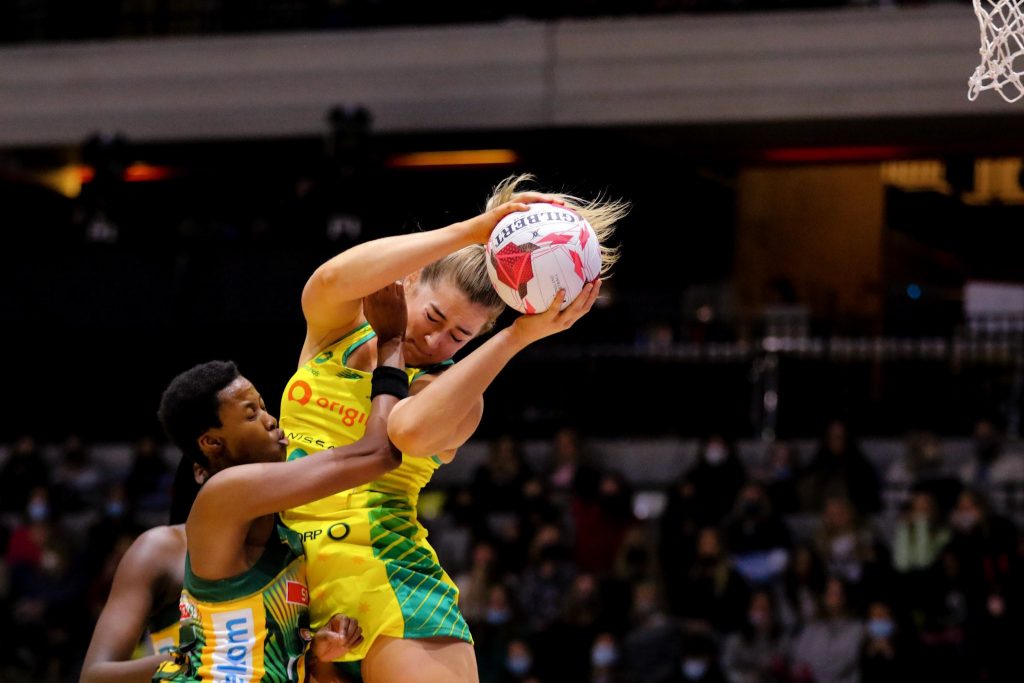
Sophie Garbin put out a solid performance in her second Diamonds cap. Image: Ben Lumley
England Roses v New Zealand Silver Ferns
Starting Line-ups
England Roses
GS – George Fisher
GA – Helen Housby
WA – Nat Metcalf
C – Serena Guthrie
WD – Beth Cobden
GD – Layla Guscoth
GK – Geva Mentor
New Zealand:
GS – Maia Wilson
GA – Tiana Metuarau
WA – Gina Crampton
C – Claire Kersten
WD – Karin Burger
GD – Kayla Johnston
GK – Kelly Jury
Player of the Match: Serena Guthrie (England)
Shooting percentages
England:
George Fisher 25/28 (89.3%), Helen Housby 24/25 (96%)
New Zealand:
Maia Wilson 32/36 (88.9%), Grace Nweke 10/15 (66.7%), Tiana Metuarau (⅘ (80%)
Umpires: Anso Kemp & Elizna van den Berg
Milestones
New Zealand captain, Gina Crampton notched up her 50th international test cap.
Talking Points
England refused to be overawed by an eight goal deficit early in the game to take a confidence-boosting three goal win over world champions New Zealand 49-46 and set up a mouthwatering encounter with world no1 Australia on Tuesday. The reigning Commonwealth champions applied immense defensive pressure throughout the court to create hesitancy in the New Zealand front line, which allowed Guthrie and Guscoth to pick up flying interceptions at key moments. Helen Housby was back to her best, with clinical shooting and confident front cuts across the top of the circle that meant the Kiwi defence could not afford to leave her alone and thus releasing Fisher under the post.
The Silver Ferns continue the search for the next Laura Langman. Kirsten and Winders both had positive moments at centre, but still lack the veteran’s ability and confidence to release a first time ball into the circle at key moments and control the pace of the game. Too often, frantic transverse passes, while retaining possession, allowed England to reset their defence and keep a smothering control over the Kiwi attackers.
Meanwhile, the Kiwi front line allowed the Roses defenders to push them deep into the court, and despite some nifty footwork on the baseline by Wilson to create space on occasion, were too often caught behind their player and offering only restricted space for their feeders to work with. Metuarua, in particular, was guilty of asking for a lateral or overhead ball, rather than driving to the top of the circle and creating space for the shooter behind her. Both she and Grace Nweke, a second half substitution for Wilson, were guilty of rushed or heavy-handed shots – their partnership can only improve with experience and confidence.
However, the biggest talking point was the injection of England’s most-capped player Jade Clarke, often the unsung or overlooked member of the Roses squad, midway through the second quarter. As is often the case, she took an immediate turnover and was soon controlling the English gameplan, swarming in defence and marshalling the frontline to release her shooters into space from the circle edge. Her ability to cut and drive through the Kiwi zone defence, in particular, was impressive and, as always, she could be relied upon to hassle the opposition into errors and turnovers while controlling the pace of the English frontline – on the evidence of today’s performance, surely Thirlby has her name on the squad list for Birmingham?
View from the Sideline
The England bench were really involved in the match. They harnessed the vibe from the crowd and made a noticeable difference between them and the Silver Ferns: even in the players not selected in the game day squad. In general the Roses look like they are having a lot of fun. There’s plenty of laughter and a relaxed atmosphere from them warming up and off court.
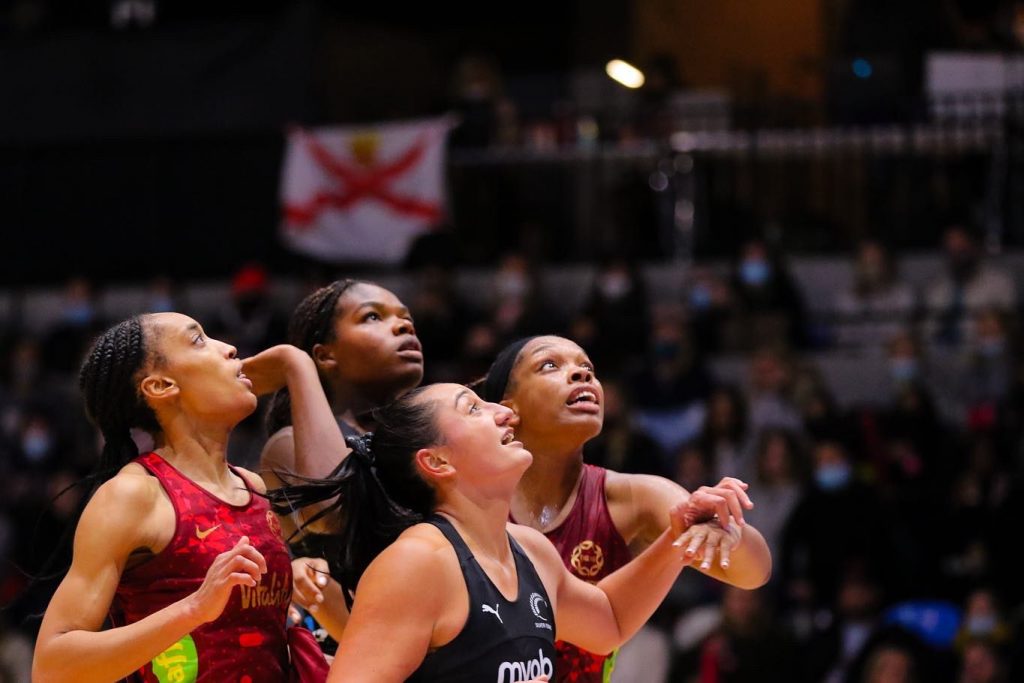
Eyes on the prize. Image: Ben Lumley
Stand out players
Jade Clarke was simply unstoppable today, and her links between attack and defence released both ends of the English side to play more freely. Serena Guthrie had another immense game for the Roses and credited Clarke as enabling her to do what she does best – making interceptions – safe in the knowledge that the veteran will act as the playmaker and backup while the English captain goes on the fly for the ball.
Elsewhere, Layla Guscoth put in another strong defensive performance, hassling and harrying Tiana Metuaru into errors and rushed shots, and backing up her front line on the transverse line at every opportunity. Her workrate is astonishing – it would be interesting to see the stats on her performance tracker.
For New Zealand, Crampton was a steadying influence in attack, putting in a tonne of work to ensure that her young shooting combination had the best possible service. Meanwhile, Burger had moments of brilliance in an enthralling contest with England’s Metcalf, with neither able to fully come out on top against the other.
Key strategies
Both coaches left their line ups largely unchanged for much of this match, allowing players the time and opportunity to work through the challenges they faced. Thirlby introduced the more physical Usoro-Brown for Mentor to provide more contested ball for Maia Wilson and the change certainly created more hesitancy for the Kiwi feeders. Meanwhile, the understanding between Guscoth and Usoro-Brown, honed at TeamBath in the Superleague, enabled the pair to switch more smoothly between the Ferns shooters, closing down the available space and putting increasing pressure onto the feed.
At the start of the game, Burger and Johnson did an excellent job of cutting out the long leads which Metcalf and Housby were attempting to push deep into England’s attacking third. However, the English attackers adapted their games, both using a drive and cut to pull back towards the ball carrier, making the feed less pressurised and keeping the Silver Ferns on the back foot.
The introduction of the taller, more static Nweke created a different challenge for the English defence, which had started to counteract the rolling movement of Wilson and Metuarau. If the young shooter can take more time on her shot, she will become unstoppable – at present she is guilty of rushing and, as a result, overshooting at key moments.
George Fisher was strong on the front hold against the rangy Jury to keep the Kiwi defender moving away from the shot, and giving away too many penalties for comfort. She, and Johnson, need to learn to adapt more quickly to the umpiring they face – too often, Fisher was left uncontested under the post.
Interesting statistics
Two statistics stand out from the rest, and both could have turned the tide of the game for either side:
The first is rebounds. The Roses did not take a single rebound for the match while the Silver Ferns snaffled 8. What’s more impressive is that most of the rebounds came from the rookie shooters Grace Nweke and Tiana Metuarau who took 3-a-piece. It’s an impressive feat against two experienced, world-class defenders, particular for Metuarau who gives away a lot of height. It is something which England will want to fix heading into the match against Australia who are aren’t giving away a lot of missed shots.
The other stat which was telling was the contact penalties: England notched 37 contacts to New Zealand’s 50. Half of the Ferns tally comes from Kelly Jury (14) and Kayla Johnson (12). In a stark contrast, Roses keeper, Usoro-Brown only notched 4 contacts for the match, with the same amount of time on the court. It begs the question, if Jury and Johnson had of spent more time in play, could they have swung the game?
Unusually, the Silver Ferns have been the most penalised team in the competition to date.
What’s ahead in Round Three
Game 5 – SPAR Proteas v New Zealand Silver Fans
Game 6 – Vitality Roses v Origin Diamonds
Hear from the athletes and coaches in the Day 2 wrap on The Netball Show and find out what their strategies are heading into Roun 3.
The Road to Birmingham 2022
Despite showing good signs at times in both matches, South Africa has had a tough start to the Quad Series, losing by 24 and 20 goals. It must be remembered that they are without three of their very best players, in Lenize Potgieter, Shadine van der Merwe and Karla Pretorius. It is to be hoped that Potgieter and van der Merwe will both be back on the team sheet when they get to the Commonwealth Games, but they will certainly be without Pretorius who is taking this year off to have her first child.
While it is brilliant news for Pretorius, it leaves a big hole in the team, as a player of her ability is really irreplaceable. She also has such a terrific combination with Phumza Maweni. During today’s game against Australia, three players were tried in the goal defence position, all with varying degrees of success. Perhaps van der Merwe will be the one to take this spot in Birmingham, instead of her more accustomed position of wing defence.
One of the problem areas in recent years for South Africa has been goal attack. They haven’t had anyone who has really grabbed that position and made it their own. Lefebre Rademan is a fine playmaker, but her accuracy can go astray, as it did in today’s game with 8/14. Even so, she appears to have the frontrunning. Ine-Mari Venter has had two strong games at goal shooter and can play goal attack too, but the front line looks better with Rademan in that position.
The switching of Bongi Msomi to centre and Izette Griesel to wing attack worked well for the first half against Australia, and South Africa will look to build their midcourt around these two. If you add van der Merwe and Potgieter into the mix, the team then takes on a more imposing look, but no Pretorius means life will be difficult for South Africa in Birmingham.
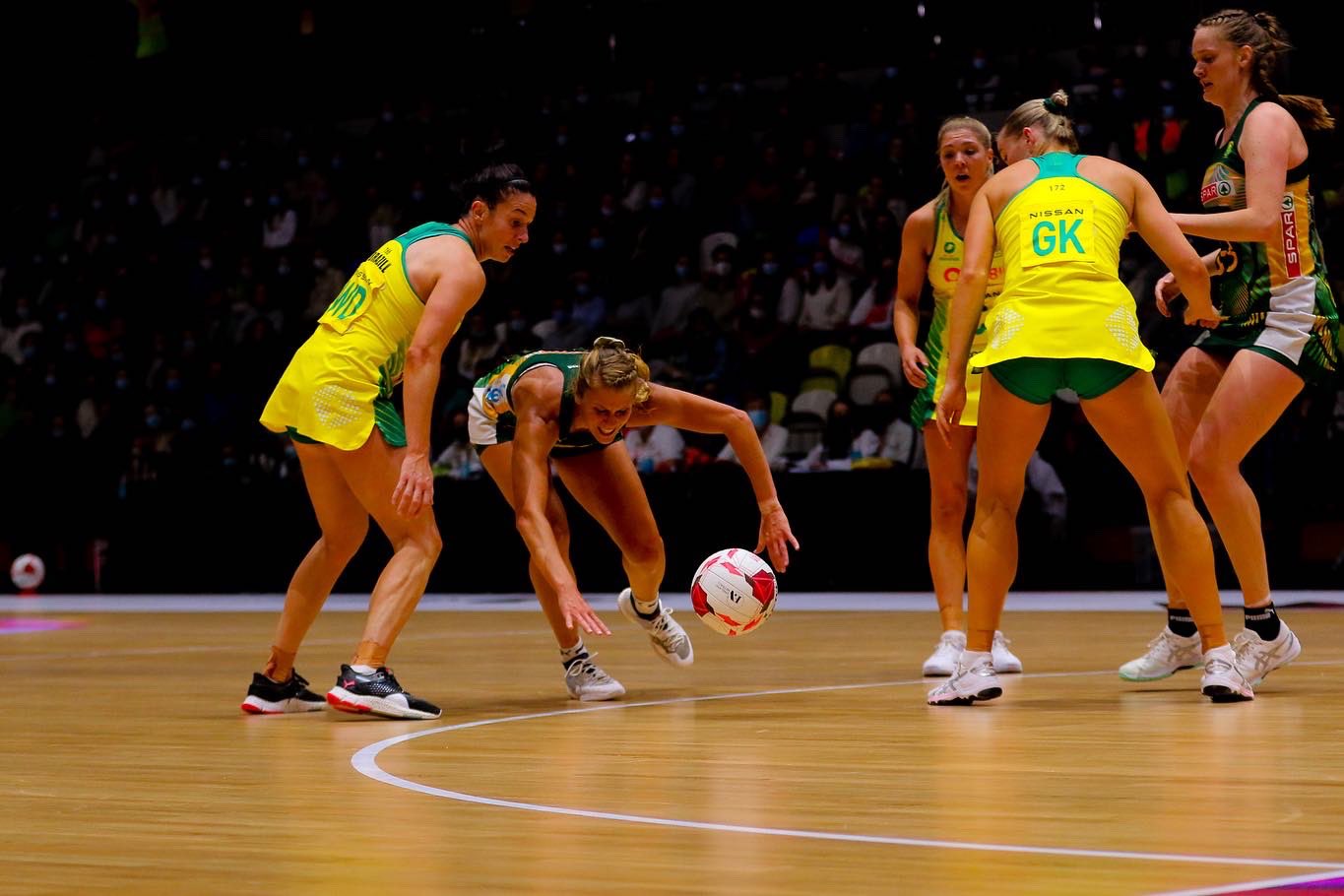
Izette Griesel keeps the ball out of Aussie hands. Image: Ben Lumley
The difference between the New Zealand team of yesterday and today was huge. There was a noticeable lift in intensity in today’s game against England. They were on top for most of the first half, before the home side came to life late in the second quarter and eventually got on top with a three goal win. There were a lot of positives to come out of the game, but also some question marks.
Again, like South Africa, it must be noted that the Kiwis are without some prominent players in Ameliaranne Ekenasio, Jane Watson, Bailey Mes and Katrina Rore. And just like South Africa’s Pretorius, Watson is taking the year off to have a baby, so she won’t be there in Birmingham. The other three still could be though. Certainly, captain Ekenasio is a very important member of the team in the goal attack position. New Zealand has won just one of its last six matches without her.
Kelly Jury played well at goal keeper against England and has firmed as Watson’s replacement for that position. Early on in today’s game, her height and reach had George Fisher spooked. Fisher gradually pulled through that, but even so, it was a defensive performance that must have pleased Taurua.
Maia Wilson started the game in excellent fashion, shooting 15/17 in the opening quarter, and eventually finishing with 32/36. The troubles that plagued her towards the end of the ANZ Premiership seem to be well behind her now. Grace Nweke was given another opportunity against England, and it’s fair to say she looked nervous, rushing and missing some close-range shots at goal. But it’s easy to forget just how young she still is. She has a big future ahead of her.
In Australia’s game today, Gretel Bueta put in another fine performance, firstly at goal shooter, then at goal attack. She is looking incredibly fit and strong at the moment and is proving to be a tough matchup for defenders. Sophie Garbin and Sunday Aryang (on her test debut) also put in performances that would have pleased Stacey Marinkovich.
Meanwhile, Kate Moloney and Jamie-Lee Price both got court time today as they try to establish themselves in the midcourt. It would appear that Watson, Hadley and Brazill have all but sealed their spots, so there is just one midcourt name to be added. Moloney possibly has the front running, but it’s hard to tell which way the selectors will go at this stage. Will they possibly pick someone who’s not even in this squad, off the back of an outstanding Super Netball season?
Finally, to England, and the return of Jade Clarke. Surely, she demonstrated in today’s game that she really needs to be in that Commonwealth Games team, if for no other reason than it gives coach Jess Thirlby the option to play her at centre and switch captain Serena Guthrie to wing defence.
That is exactly what happened today and to great effect. Clarke was simply tremendous, running the show with all of her experience, while Guthrie took out the player of the match award with a dominant display. Once again, Helen Housby was phenomenal at goal attack and the spark behind the team’s second quarter comeback.
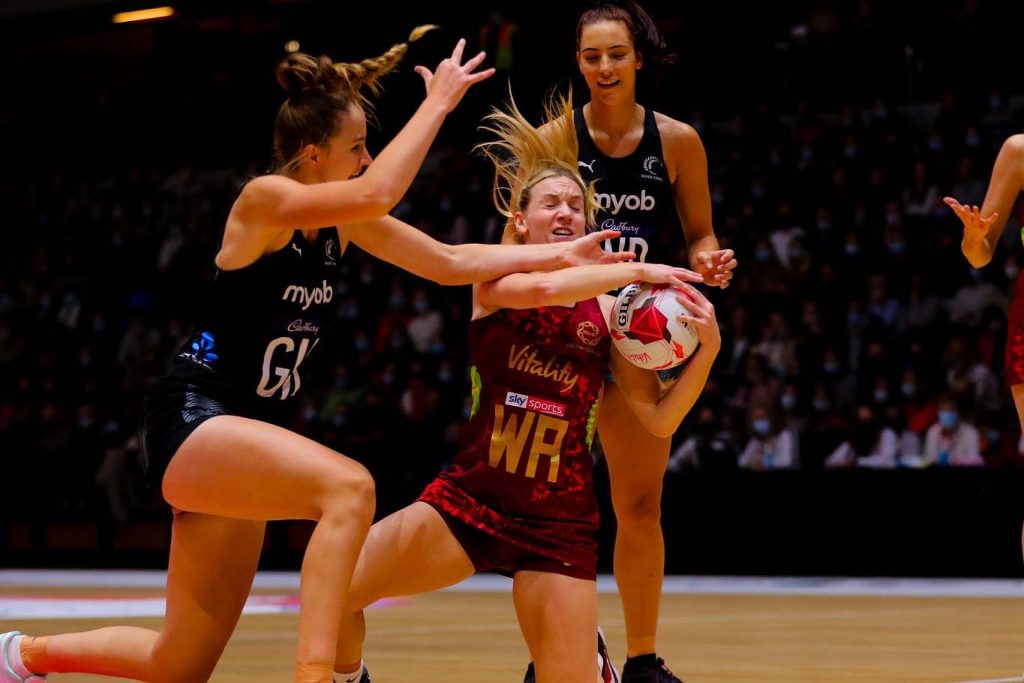
Nat Metcalf maintains possession under strong defence from Kelly Jury. Image: Ben Lumley
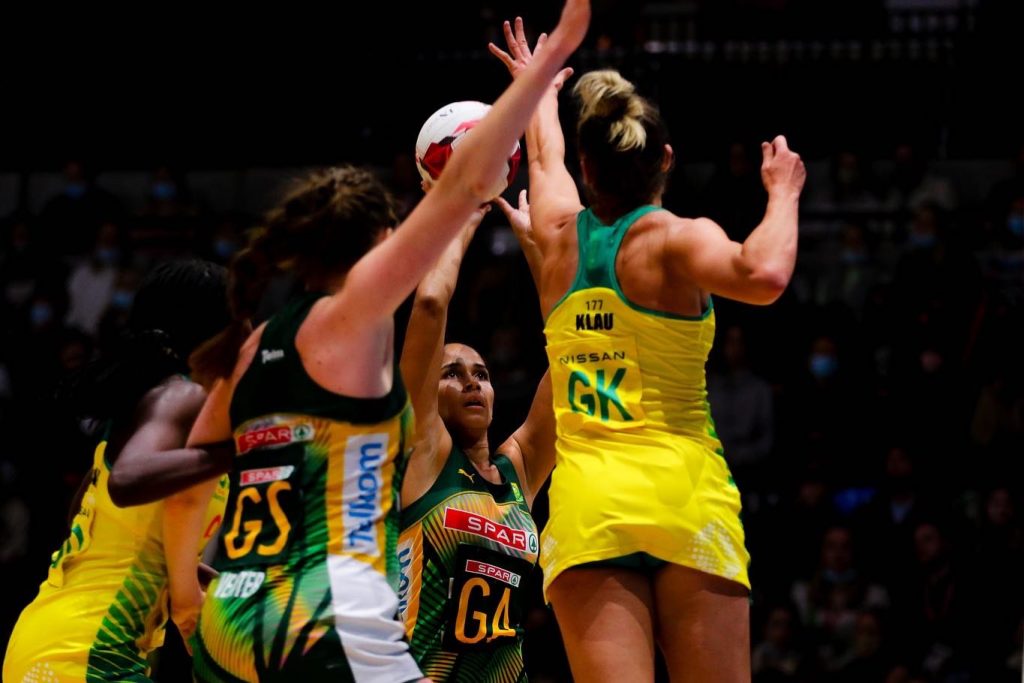
Jessica Du Plessis puts a shot up under pressure from Sarah Klau. Image: Ben Lumley
